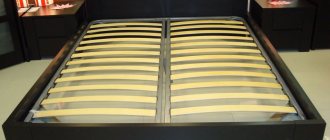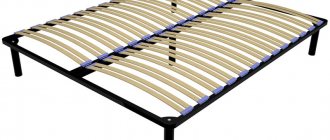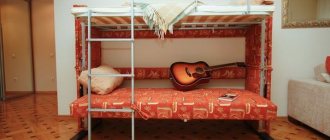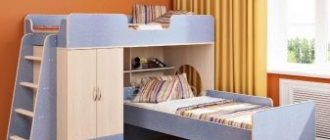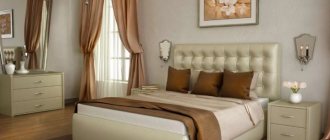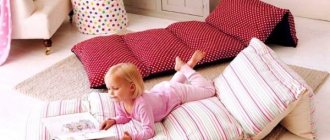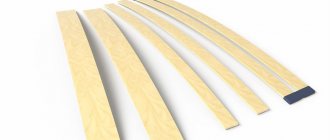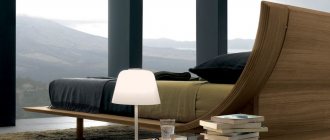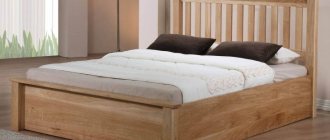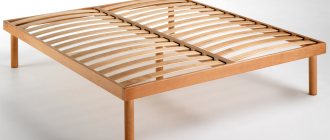Beds with springs have long since sunk into oblivion and have been replaced by modern models with orthopedic bases. Their design is like two peas in a pod and consists of a wooden box, a metal frame and one or two rows of lamellas - curved panels. The latter are responsible for the orthopedic properties of the sleeping place and take on the weight of the mattress and the person resting on it. What are slats for beds and what are their advantages over springs? Let’s look into this article.
Slats are wooden plates, panels that make up the base of any modern bed. Their feature is a curved C-shape and the ability to withstand the large weight of a mattress + a person. Reiki can be made from:
- Birch is a plastic and affordable material;
- Linden trees are an inexpensive alternative;
- Beech;
- Ash;
- Maple.
Birch slats, or battens, are the most popular and affordable orthopedic slats. Beech and ash components are more expensive and are usually installed in 100% solid wood beds.
The orthopedic base of the bed is assembled like a puzzle - from a couple of dozen slats and a common metal frame that holds them together.
Wooden strips create a slatted bottom on which an orthopedic mattress is placed.
Modern mattress models do not tolerate uneven and questionable surfaces and are quite heavy in weight, and the slats, in turn, provide:
- Natural ventilation for the mattress due to the small distance between each of them;
- Reducing the load on the mattress and bed frame;
- They increase the anatomical effect of the mattress, that is, they complement its orthopedic properties;
- They create a light springy effect due to their curved shape, so this base does not creak or make other irritating sounds;
- They extend the life of the bed because they completely take on the weight of the mattress.
It is not for nothing that the slatted base of the bed is called orthopedic: it evenly distributes the load on the vacationer’s spine, providing him with high-quality and complete sleep.
The slats allow the mattress to “breathe” and remove moisture from it. We wrap every new mattress in a waterproof mattress cover, which can create a real greenhouse effect inside it. The slatted bottom eliminates this problem, and the orthopedic “friend” continues to serve us faithfully for decades.
The slats are sold as part of an orthopedic base in a bed and separately - individually. Like any other element of the stock, they are subject to stress and can break.
Experts do not recommend sleeping on a bed even without one lamella: firstly, the load on the other parts of the bed increases and their integrity is called into question, and secondly, the orthopedic properties of the mattress and base, which are designed to evenly distribute the load on the spine and ensure healthy sleep, are reduced.
The slats are sold individually or as a set according to the size of the bed or sofa, so if one plank is cracked or completely broken, replacing it will not be difficult; all that remains is to choose the right replacement in terms of thickness and width.
A set of slats can be sold on a strip if your bed uses this slatting system (by the way, it is already outdated). Additionally, you will have to buy spare parts for attaching the rail: a cap-holder (internal or overhead).
There are component caps that hold the slats and are attached to the metal base of the bed without “intermediaries.”
There are two types of slats: wide and narrow:
- Wide slats, about 900-1000 mm long, are installed in one row on the lattice and are often used in single or one-and-a-half beds. Slats across the entire width of the bed are suitable for springless mattresses and models with Bonnell springs.
- Narrow ones (700-800 mm) are arranged in two rows - each for one sleeping place. This type of lamella arrangement is recommended for mattresses with independent springs.
If we talk about the number of elastic panels, then the best option is 26-30 pieces for a double bed. For a single bedroom, the number of slats is half as much - 13-15 pieces. The greater the number of slats, the better: this number of slats ensures optimal flexibility of the bed base and can withstand more weight.
The lamellas differ in thickness, length, width and the distance that is formed between them. The optimal thickness of the slats is 8-10 mm, width is 5-7 cm, the length can vary depending on the width of the bed (140 cm, 160 cm, 180 cm - each of them will require slats of different lengths). There should be a distance between the slats no more than the width of one of them - about 4-7 cm.
There is another important classification - according to the type of lamella holders. Modern manufacturers attach latoflexes to special holders made of:
- Plastic;
- Rubber;
- Polypropylene.
The slats on a strip or attached to a metal frame also move to the side, making room for a practical and lightweight fastening, which, in the event of a break, allows you to replace the latter yourself.
It is impossible to say which slats are better. If we talk about their fastening, it is better to choose rubber or polypropylene holders - they are stronger and better than their plastic counterparts.
Beds vary in sleeping size, and each will require different lengths of slats.
For a double bed 180x200 cm, slats with a width of 880885 mm are suitable, for a single bed - 900-990 mm, provided that the slats are lined up in one row, and 500 mm - for a pair of rows of slats.
The slats can differ in size and even in bending angle, so before replacing and purchasing a separate slats, it is important to measure the length and width of the already installed parts in order to choose exactly the same one.
The lamellas differ in width - 40, 50, 70, 80 mm, but their thickness remains practically unchanged, the ideal is 8 mm.
When buying a bed with an orthopedic base or slatted bottom, pay attention to the number of slats.
The more there are, the better, experts say. And the wider the bed, the greater the number of slats should be at its base.
The optimal number of slats on a bed frame is 20-22 pieces for a bed 190-200 cm long. If there are more slats, then such a bed will be softer, more flexible and more functional, and will withstand more weight of the mattress. The slats differ not only in quantity, but also in the material from which they are made.
The most affordable is birch, which is not inferior in strength to harder wood species.
Birch slats are usually installed in economy and mid-segment beds. At the base of solid wood beds there are beech slats - strong and solid slats. Give preference to rubber or semi-propylene rack holders; plastic ones wear out quickly and are not so practical to use.
When choosing a slatted bed base, pay attention to the distance between the slats: it should not be greater than the width of the slats. If it is large, then the springless mattress will fall into these “holes,” and the slats themselves will soon fail and fail, since they will not be able to withstand the heavy weight.
When buying a double bed with a width of 140 cm or more, choose a model in which the slatted bottom is divided into two halves. This way, each bed will have its own slatted base. It is logical to assume that this type of stock uses shorter slats.
Why does the rack bottom squeak?
Rack and pinion
bed base - the structure
creaks
due to the contact of wooden parts or breakage of fasteners; Mattress – it is not the mattress itself that makes the sound, but its springs. ... Legs - because the bed is uneven, an unpleasant sound may appear when they touch the floor. The furniture shrinks and gaps form.
Interesting materials:
Should hollyhocks be pruned in the fall? Should lilacs be pruned in the fall? Should plum trees be pruned in the fall? Do I need to prune plum trees when planting in the fall? Should Victoria be pruned in the fall? Should jasmine be pruned in the fall? Should honeysuckle be pruned in the fall? Is it necessary to pick off the buds on roses in the fall? Should strawberries be plucked in the fall? Do you need to spray trees in the fall?
To have a successful day, it’s not enough to just get up on the right foot.
First you need to get a good night's sleep! IKEA has a good selection of single and double beds. The price range is quite large, so there is a chance to find a model for virtually any budget. Most of the beds are part of a series - you can easily match them with bedside tables, chests of drawers, wardrobes and other pieces of bedroom furniture. When choosing beds from IKEA, there are several nuances that are worth considering.
- BED SIZES
The standard sizes of beds (and therefore mattresses, mattress covers and fitted sheets) at IKEA are as follows:
Single beds 90x200 cm and 120x200 for some models.
Double beds 160x200 cm standard bed, and 140x200 and 180x200 additional beds
You can select the bed size on the main page of the site - there is a drop-down window with all size options for this model.
- PRICING
If you look at the beds section of the website, you will find that some identical-looking beds have different prices. The difference is that it is a bed frame and a bed frame with slatted bottom. A slatted bottom is always sold in a separate package, a simple bed consisting only of a frame is sold in a box (or boxes) with one article number, and a combination of a bed and a slatted day is sold in several. Thus, if you already have an IKEA bed that you want to change, you can replace only the frame itself (frame) and save a little.
Please note that when placing an order, we write down each component separately to eliminate errors during delivery, which is why when you send us one link to the bed, in the order you will see two or three lines with each of the bed components.
- BED COMPOSITION
Single beds consist only of a frame and a bottom (the same applies to cribs), while double beds also have a central crossbar. It is placed in the middle of the bed for additional support. The crossbar is sold in a separate package, but is included in the price of the frame. A mattress is placed on top of the slatted bottom and, if desired, an additional thin mattress, which makes the sleeping area even more comfortable.
- SLATT BOTTOM (SLAMS)
IKEA offers a slatted bottom as a base for beds - it is easy to use, well ventilated, made of wood, and therefore non-toxic and hypoallergenic.
At the moment, IKEA has several types of slatted bottoms. All of them meet safety standards, so you can save money and take the cheapest one. However, if you need additional comfort, IKEA gives you the opportunity to choose. Keep in mind that the thicker your mattress and the lighter the weight of the people sleeping on the bed, the less noticeable the difference. The simplest and most inexpensive LUROY bottom - has dimensions of 70, 80, 90 and 120 x200 cm. Slightly curved 17 multi-layer birch slats for optimal support, this slatted bottom comes with a 25-year guarantee (in fact, it lasts forever, unless you deliberately try to ruin it )
The LONSET bottom is somewhat more expensive, it has a more complex design. The bottom consists of 28 slats and has several comfort zones that adapt to weight. It also comes with a 25-year warranty. (Available sizes: 70, 80, 90 and 120 x200 cm)
The LEERSUND bottom is relatively expensive, but it consists of 42 slats and, in addition to the comfort zones, slats with adjustable rigidity are installed in the lumbar area. That is, in essence it is practically an orthopedic bottom. Sold in sizes 80x200 and 90x200 (can be used with beds 160x200 and 180x200)
And there is also a LAXEVOG bottom with an electric drive - the position of the headboard and footboard is adjusted using the remote control. Unlike the others, you cannot use a spring mattress with this base, only polyurethane foam or latex mattresses.
You can choose any beds (as well as other products) from the IKEA range, we will be happy to deliver them quickly, without prepayment and at a competitive price. We will answer all questions and help you with your choice. To make a reservation, simply fill out the simple form on this page.
IKEA beds
All bedroom furniture and accessories
All our review articles
Bed repair, tips for beginners, basic rules
No matter what the furniture is made of, it will break down over time. Naturally, in this case, you can purchase a new product, but repairing beds at home will ensure a longer service life of these items and will save money. Restoration is not difficult if you follow the technology of the work. It is also important to study possible errors in advance.
Basic Rules
Repairing broken bed elements does not require such a careful approach as, for example, repairing mirrors, but it still cannot be done without preliminary preparation. It is also necessary to select materials and tools, find out the cause and type of damage. In addition, it is important to follow certain rules for carrying out work:
- before screwing in the screws, holes are specially drilled for them, the depth of which is 2/3 of the length of the fastening element, and the diameter is 3/4 of its diameter;
- before screwing in the screws, the prepared hole is filled with PVA glue or a polymer-based emulsion;
- It is better to choose nails with a ring notch;
- It is also recommended to coat the joints of parts with glue;
- nails are hammered only some time after gluing the parts (12–16 hours).
The dimensions of the fasteners must correspond to the dimensions of the furniture.
To carry out the work, the following tools are required:
- drill with wood drills;
- chisels of different sizes;
- plane and mallet;
- hammer;
- screwdrivers or screwdriver;
- nail puller;
- clamps.
You also need saws with teeth of different sizes or a jigsaw. Additional tools are: ruler, tape measure and square, knife, pliers or pliers, furniture stapler. The composition of items for repair may vary depending on the type of breakdown.
Before screwing in the screws, the prepared hole is filled with PVA glue or a polymer-based emulsion
It is also recommended to coat the joints of parts with glue during the repair process.
You can hammer in nails only some time after gluing the parts (12–16 hours)
Failure options and fixes
To repair a bed at home, you must first find out the cause and type of damage. Most often it is necessary to restore the legs, slats, frame of the product, as well as the spring mattress. The technology for carrying out work is different in each case.
Leg repair
If the entire structure is attached to the legs, then bed repairs must be carried out very carefully. When parts become loose, the fasteners must be tightened. If they break, it is better to completely replace them.
To do this, the nuts are unscrewed, damaged components are removed, and others are installed in their place and clamped with fasteners. Ready-made parts can be purchased or made independently.
If the master is a beginner, then the first option is preferable.
Options for large bed sizes, their main pros and cons
If the legs become loose, the fasteners need to be tightened
If a leg breaks, a complete replacement of the part is required.
Bed frame, pine/Luroy 160; 200 cm IKEA NEIDEN NEIDEN
Compact sizes are suitable for small spaces or rooms with low ceilings. Maximum efficient use of available space.
Delivery to Minsk
- Description
- Reviews (0)
Dimensions NEIDEN NEIDEN
Accompanying documents for assembly and installation. (Download file)
Product instruction manual. You can only download the latest versions of documents. This means there may be differences between this version of the file and the printed version.
| vendor code | Assembly Instructions |
| 703.952.44 | NEIDEN NEIDEN Bed frame (PDF) |
Making your own sun protection
In Ikea and other home improvement stores you can purchase not only finished products, but also materials for making curtains with your own hands. If a needlewoman decides to make such blinds on her own, for work you will need:
- Bamboo or plastic frame;
- Metal fasteners or ordinary Velcro to secure the canvas;
- Dense material for blinds;
- Thick cord.
Making such a curtain is much easier than sewing traditional curtains. To do this, you just need to take the necessary measurements and prepare a piece of material of the required length and width. It can be either non-woven material or dense fabric. But you should keep in mind that non-woven curtains are easier to clean. It is advisable to purchase material with a reserve, because the curtain is still rolled up to the desired length. A rectangular piece of fabric of suitable size is secured using metal fittings.
Materials for making a hard bottom
Much depends on what kind of boat you have and what kind of bottom you need “at the exit”. For light and small models, you can also make a slatted sling. But in large boats it will not provide the necessary stability. We recommend equipping larger models with plywood or aluminum flooring.
Think in advance about the rigidity of the structure, because stability and ease of movement depend on it. There should be no deflections, cracks or other defects. Some tips for choosing the material and shape of the bottom:
- The rake does not provide a truly rigid bottom, without deflections. If you decide to use a slatted bottom, move on it carefully.
- Plywood and metal are ideal options for flooring. This flooring can completely cover the bottom from bow to transom, allowing you to safely move and distribute the weight of the cargo.
- A book-shaped sling is a conventionally solid structure. On the one hand, it is comfortable, on the other hand, it does not provide good rigidity. Half a book is suitable for those who want to quickly assemble and disassemble the boat.
- The H-profile floorboard is more stable but suitable for smaller boats. The flooring is hard.
